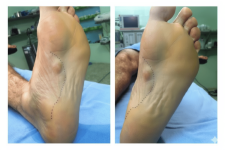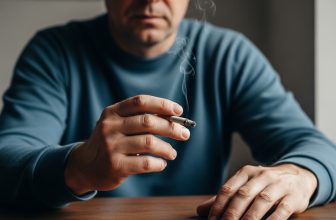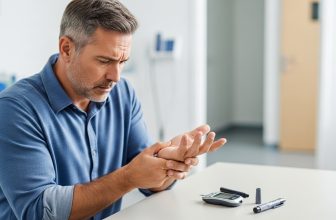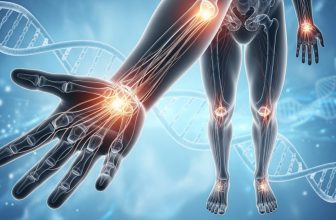
Ledderhose Disease and Dupuytren’s: Understanding the Connection
Ledderhose Disease and Dupuytren’s: Understanding the Connection
Introduction
Many people with Dupuytren’s contracture are surprised to learn that similar lumps and cords can form in their feet—a condition known as Ledderhose disease or plantar fibromatosis. Both belong to the same fibroproliferative family, where abnormal collagen accumulates in the fascia. Recognizing their shared roots helps patients take proactive steps toward whole-body care.
What Is Ledderhose Disease?
Ledderhose disease causes firm nodules on the soles of the feet, typically along the arch. These nodules may become painful when walking or standing. Over time, the fascia thickens and shortens, pulling the toes inward—much like Dupuytren’s cords draw the fingers toward the palm.
Although it can occur independently, 15–25 % of people with Dupuytren’s eventually develop Ledderhose disease, often years later.
Shared Causes and Mechanisms
Both conditions arise from overactive fibroblasts, the collagen-producing repair cells of connective tissue. In Dupuytren’s and Ledderhose, fibroblasts remain permanently “switched on,” depositing collagen as though the tissue were still injured.
Inflammation, oxidative stress, and repetitive micro-injury all fuel this process. Genetics also matter—people of Northern European ancestry face higher risk for both.
Symptoms and Diagnosis
Ledderhose nodules feel rubbery under the skin and enlarge slowly. Ultrasound or MRI imaging confirms diagnosis and distinguishes fibromas from cysts or fatty growths. Early stages bring mild tenderness; advanced disease may restrict mobility or cause pain with every step.
-
Treatment Options
The treatment of Dupuytren’s-related conditions in the foot—often called Ledderhose disease—follows a similar approach to that used for hand involvement. The goal is to preserve mobility, reduce pain, and prevent nodules from progressing into disabling contractures.
Stretching and Massage:
Gentle stretching of the plantar fascia and surrounding muscles helps maintain flexibility and relieve tension across the arch. Regular massage using a soft ball or roller can improve local blood flow, break up fascial adhesions, and keep collagen fibers more supple. These techniques are most effective when performed daily and combined with proper warm-up routines before activity.Custom Orthotics:
Supportive insoles or orthotic inserts are often prescribed to off-load pressure from painful nodules. By redistributing weight evenly across the foot, orthotics reduce irritation and make walking more comfortable. Patients who spend long hours standing or walking typically notice significant relief after a few weeks of consistent use.Injections and Medical Therapies:
In some cases, physicians may recommend steroid injections to reduce local inflammation and swelling, or collagenase (Xiaflex) injections, which help dissolve fibrous tissue—similar to their use in Dupuytren’s Contracture. These treatments are typically reserved for moderate cases where nodules are tender or expanding but surgery is not yet required.Surgical and Emerging Options:
When nodules become large enough to interfere with footwear or cause chronic pain, surgical excision may be necessary. Postoperative physical therapy ensures proper healing and reduces recurrence risk. Emerging therapies such as shock-wave therapy and low-dose radiation have shown promise in early studies by reducing pain, inflammation, and fibroblast overactivity.Overall, early detection and a tailored treatment plan combining conservative therapy, biomechanical support, and medical interventions can dramatically improve comfort and maintain long-term mobility.
What the Science Says
A 2021 Journal of Clinical Medicine study found identical collagen type III and cytokine patterns in both disorders. Researchers concluded Dupuytren’s and Ledderhose are “localized expressions of a systemic fibroproliferative disease.”
Takeaway for Patients
If you notice new lumps in your feet, mention them to your doctor early. Monitoring and supportive therapy can ease discomfort and reveal whether fibrosis is spreading systemically. Reducing inflammation through nutrition and lifestyle benefits both hands and feet.
Key Takeaways
- Ledderhose and Dupuytren’s share collagen-overactivity and fibroblast dysfunction.
- Roughly 1 in 5 Dupuytren’s patients also develop plantar nodules.
- Early detection + soft-tissue therapy improve comfort and mobility.
- Inflammation control and proper footwear reduce pain and recurrence.
Attribution (CC BY 4.0): Adapted from Rombouts JJ et al., Clinical Overview of Plantar Fibromatosis (Ledderhose Disease), J Clin Med 2021;10(9):1917.
For the complete article and references, click Source.
Call to Action: Join our Dupuytren’s community for support → Facebook Group. Discover complete treatment strategies in Dupuytren’s Solutions (launch November 2025) at DupuytrensSolutions.com.






